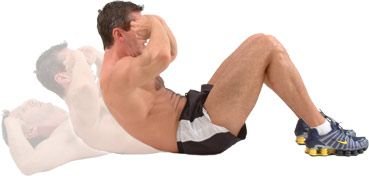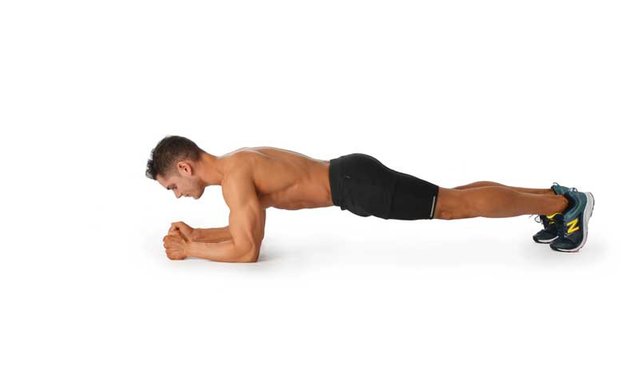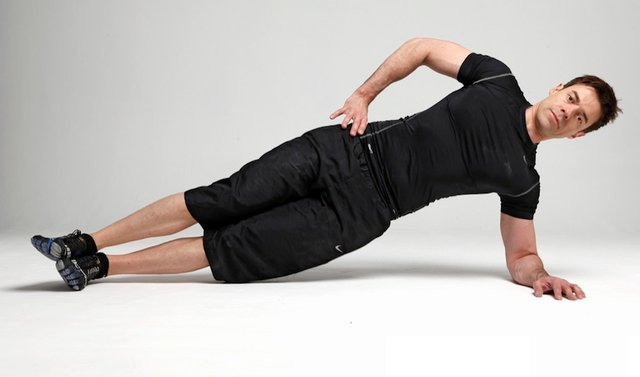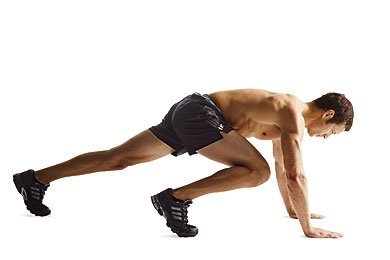La verdad tras los abdominales

Primeramente, debo decirles que la verdad absoluta no existe, mucho menos en lo que a actividad física se refiere, simplemente son juicios que se extraen desde el conocimiento, por medio de la experiencia. Siempre debemos tener en mente un objetivo, ya sea que quieras marcar abdominales para mostrarlos, mejorar en el deporte que practicas, o tener un "core" fuerte.
Como en todo, hay planteamientos a favor y en contra. ¿Por qué hacer el crunch? considero que es un complemento necesario para el correcto fortalecimiento de abdominales. Les traigo otra opinión que me parece excelente comentario de Agustín Delgado (usuario de la página en que comentó) donde favorece a dicho ejercicio, en un artículo de ‘PowerExplosive’ titulado: enterrando el ‘crunch abdominal’, aquí parte de lo que escribió: "Es bueno que la población coja conciencia cada vez más de las leyes que rigen el entrenamiento físico con vista a evitar seguir patrones equivocados. Sin embargo, hay una serie de detalles con este artículo con los cuales no estoy de acuerdo, sobre todo porque se nota la intención de plantear lo que muestra la “evidencia científica”, pero que hace falta desgranar con pinzas para que a la hora de prescribir ejercicios a los pacientes se entiendan que no todo es “blanco o negro”.
Lo primero es destacar la estructura anatómica de un disco vertebral. Los anillos fibrosos que rodean al núcleo pulposo por su composición y orientación ofrecen una resistencia enorme a las fuerzas de cizallamiento en un disco sano. Pretender extrapolar que una flexión del tronco en decúbito supino suponga un gran daño al mismo es un error. Está diseñado para esto y para mucha más carga y por tanto prohibir los ‘crunch’ sin llegar a prohibir ejercicios también que ejercen mucha presión a los discos como el peso muerto es un sinsentido, y sobre este último no se dice nada. Tampoco es cierto aquel mito que prohíbe hacer las hiperextensiones del tronco, por el mismo mecanismo, aunque ese es otro tema. Ambos ejercicios son seguros, recomendables SIEMPRE Y CUANDO SE APLIQUE LA LÓGICA EN CADA SUJETO: es decir, su edad, nivel de entrenamiento, estado previo de su columna y la progresión que se haga a la hora de escoger un determinado ejercicio. Por lo tanto no es lógico poner a hacer ‘crunch’ a un sujeto obeso, con hernia discal desde el primer día, y a la vez es un ejercicio muy válido si tienes un buen nivel de entrenamiento físico.
En segundo lugar, destacar que lo que más daño puede ocasionar a nuestra columna, sin duda alguna, es la sedestación prolongada con retroversión de la pelvis. Los discos vertebrales sobre todo, necesitan del movimiento de las vértebras adyacentes porque es la manera de aumentar el flujo de las arterias espinales y poder tener una optima nutrición y oxigenación. Recordemos que al disco y al núcleo pulposo le llega oxígeno y glucosa por difusión desde las arterias espinales adyacentes y si no hay movimiento el deterioro es rápido y progresivo. Sobre esto, no se ha investigado nada o muy poco y casi todo lo que se publica es repetir una y otra vez los paradigmas de moda.
Tercero, como bien dices, la EMG es un indicador de activación muscular, pero no lo es del gasto metabólico que puede tener un músculo. Por lo tanto si se quiere fortalecer CUALQUIER TIPO DE MÚSCULO ESQUELÉTICO hay que generar deslizamiento entre sus miofibrillas. Planteo esto para que se entienda que haciendo isométricos solamente o menos aún contrayendo la musculatura abdominal, no vas “a sacar los cuadritos” como se diría vulgarmente. Hay que entender que la grasa en la región abdominal se distribuye intraperitonealmente (la visceral) con sus particularidades metabólicas y endocrinas y la que discurre entre los fascículos de los músculos abdominales; y por tanto eliminando la primera al mínimo NO es garantía segura de eliminar por completo la segunda.
En fin, no es este la página para exponer todos estos detalles demasiados técnicos, pero sí me pareció oportuno hacerlo, porque con la búsqueda incesante de internet los pacientes a veces acuden con ideas muy preconcebidas, y es difícil recomendarles algo diferente a lo que han visto por la web. Aclarar que hay dos principios muy simples que todo profesional que se dedique a esto o a la medicina como es mi caso, deben seguir:
- Si no tienes idea de algo HAS LO QUE MUESTRA LA EVIDENCIA CIENTÍFICA.
- Si tienes los suficientes conocimientos de un proceso desde todos los puntos de vista y aun así pretendes seguir al 100% la evidencia científica ESTAS COMETIENDO UNA ABERRACIÓN. Eso se llama no tener sentido común.
Perdonen la extensión y continúen así chicos.”
Al escribir "sedestación prolongada con retroversión de la pelvis" se refiere a estar más de 30 minutos sentados de seguido, y con una postura incorrecta. Con todo esto él escribe que hacer el típico abdominal, o no, depende de tu condición física, y que además es un ejercicio muy importante , muchas veces tergiversado. Si se quiere, otros puntos de vista, sería el entrenamiento de Usain Bolt y de Jeff Cavaliere, ellos promueven el "crunch".
Ahora vamos al abandono del ejercicio, David Marchante de Power Explosive dice las razones
Al igual que Marcos Vásquez de Fitness Revolucionario:

"El típico ejercicio de abdominales en el que muchos centran su entrenamiento abdominal es uno de los menos recomendables. Aislar los abdominales flexionando constantemente la columna no es buena idea. El ratio riesgo/beneficio es poco favorable. Hacemos el ejercicio más peligroso todavía al colocar las manos detrás de la nuca, ya que nos tienta a tirar para ayudar en la subida, poniendo más presión en la columna. Puedes hacerlos de vez en cuando, pero desde luego no deberían ser la base de tu entrenamiento abdominal."
Exacto, “puedes hacerlos de vez en cuando”, no lo tomes como el ejercicio principal de tu núcleo. La cuestión no es entrenar 1 h, hacer cientos de abdominales (que no sirven de nada) y luego llegar a tu casa, ser sedentario, y tener una alimentación desequilibrada, sin embargo eso es otro tema. No hay que creernos todo lo que nos dicen sobre los ejercicios “lesivos” en este caso el ‘crunch’, debemos averiguarlo por nuestra cuenta, ya que algunas fuentes y hasta instructores de gimnasio tienden a generalizar, si fuese por eso, la sentadilla sería lesivo, lo que no te dicen es que por su indebida ejecución tiende a generar lesiones. El cuerpo se fortalece de manera holística, no vayas a creer que haciendo solo “ejercicios de abdominales” tendrás tus "cuadritos", debes entrenar en conjunto, y además cuidar tu alimentación, reducir el porcentaje de grasa corporal es la clave. ¿Qué comer? Comida real: plátano, papa, arroz, arveja, caraota, ocumo, auyama, la mayoría de granos; carne con frecuencia moderada, vegetales, cambúr, agua de avena, entre otras frutas. A evitar: frituras, margarina, pan, jamón, galletas, todo lo referente a bollería, harina de trigo, en pocas palabras los procesados, azúcar agregada (azúcar blanca); sustitúyela por panela o azúcar morena, al escribir "evitar" significa que las consumas una o dos veces al mes. NOTA: no te guíes de las 3 comidas, come solo cuando tengas hambre, muchas veces tenemos ‘hambre emocional’, que se quita hasta tomándose un vaso de agua.
Aunque los puntos de vista en contra del típico abdominal, tienen algo de verdad en lo que plantean, mi recomendación es que puedes hacer el ´crunch´si no tienes hernia lumbar o problemas en la espalda, también si tienes una buena condición física para hacerlo, mientras, intenta con:

plancha abdominal, comienza con 20 segundos si eres principiante, y hazlo 3 veces, descansando aproximadamente un minuto por serie.

plancha lateral, trabaja 3 series de 15 segundos si estás comenzando, y alterna los lados

el escalador, comienza con 3 series de 15 repeticiones en total (alternando las piernas) descansando un minuto por serie.
A medida que vayas avanzando agrégale peso o varía la intensidad. Y sí, las mujeres, siempre y cuando su condición se los permita, pueden entrenar los mismos ejercicios abdominales que los hombres.
The truth about ABS
First of all, must tell you the absolute truth does not exist, much less that physical activity is concerned, simply are judgments that are extracted from knowledge through experience. We must always bear in mind an objective, whether you want to mark abdominal to show them, improve in the sport that you practice, or have a "core" strong. "
Like everything, there are approaches in favour and against. Why do the crunch? I believe that it is a necessary complement to correct abdominal strengthening. I bring you another opinion which I think is excellent comment from Agustin Delgado (user of the page that said) where favors to this exercise, in an article entitled 'PowerExplosive': burying a 'abdominal crunch', here part of what wrote: good "Es that take population awareness more and more of the laws that govern the physical training with a view to avoid follow wrong patterns. However, there are a number of details in this article with which I disagree, especially because note intended to consider showing the 'scientific evidence', but that makes missing reel off with Tongs so that at the time of prescribing exercise to the pa cient understand that not everything is "black or white".
The first thing is to highlight the anatomical structure of vertebral disk. The fibrous rings surrounding the nucleus pulposus by its composition and direction offer a huge resistance to the forces of shearing on a healthy disk. Trying to extrapolate a flexion of the trunk in supine to suppose a great harm to the same is a mistake. It is designed for this and much more load and therefore prohibit the 'crunch' to prohibit exercises also to exert too much pressure to the disks as the dead weight is nonsense, and on this last does not say anything. Neither is true that myth which prohibits the hyperextension of the trunk, by the same mechanism, but that is another issue. Both exercises are safe, recommended provided you apply the logic in each subject: i.e., their age, level of training, previous state of your column and progression that is made when choosing a particular period. Therefore it is not logical to put to 'crunch' to an obese subject with herniated disc from the first day, and at the same time is a very good exercise if you have a good level of fitness.
Second, note that what more damage can cause to our column, without a doubt, is the sitting extended retroversion of the pelvis. Vertebral discs especially need the movement of adjacent vertebrae because it is the way to increase the flow of spinal arteries and to have an optimum nutrition and oxygenation. Remember that disk and nucleus pulposus becomes you oxygen and glucose by diffusion from the adjacent spinal arteries and if no movement the deterioration is rapid and progressive. About this, he has not investigated nothing or very little and almost everything that is published is to repeat again and again the paradigms of fashion.
Third, as you say, the EMG is an indicator of muscle activation, but it is not metabolic expenditure that can have a muscle. Therefore if you want to strengthen any type of SKELETAL muscle there to generate sliding between the myofibrils. I put this so that they understand making only isometric or even less to contract the abdominal muscles, you will not "to get the squares" as it would commonly say. It must be understood that the fat in the abdominal region is distributed (the visceral) intraperitoneally with their endocrine and metabolic particularities and which runs between fascicles of the abdominal muscles; and therefore eliminating the first minimum is not safe guarantee of eliminating completely the second.
Anyway, this is not the page to expose all these details too technical, but I found it appropriate to do so, because with the relentless pursuit of internet patients sometimes come with very preconceived ideas, and is difficult to recommend something different from what they have seen on the web. Clarify that there are two very simple principles that all professionals devoted to this or to the medicine as it is my case, should be followed:
- If you do not have idea of something HAS which shows the evidence scientific.
- If you have enough knowledge of a process from all points of view and still intend to follow 100% scientific evidence these committing an ABERRATION. This is called not to have common sense.
Forgive the extension and continue thus to guys."
Writing extended retroversion of the pelvis "sedestación" refers to be more than 30 minutes sitting followed, and with incorrect posture. " With all of this he writes to do the typical abdominal, or not, depends on your physical condition, and it is a very important exercise, often distorted. If you want to, other points of view, it would be the training of Usain Bolt and Jeff Cavaliere, they promote the "crunch". "
Now we are going to the abandonment of the exercise, Power Explosive David art dealer says the reasons
As Marcos Vásquez de Fitness Revolucionario:
( )
)
Typical "El of abdominal exercise in which many focus their abdominal workout is one of the least recommended. Isolate the abdominal muscles constantly flexing the spine is not good idea. The risk/benefit ratio is unfavorable. We do the most dangerous exercise still to place the hands behind the neck, since he tempts us to pull to help on the rise, putting more pressure on the column. "You can make them from time to time, but certainly should not be the basis of your abdominal workout. "
Accurate, "you can make them from time to time", do not take it as the main exercise your core. The issue is not training 1 h, do hundreds of sit-ups (which do not serve of anything) and then get your home, being sedentary, and unbalanced nutrition, yet that is another issue. You shouldn't believe everything you tell us about the "harmful" exercises in this case the 'crunch', we should find out on our own, since some sources and even gym instructors tend to generalize, if it were so, the squat would be injurious, what do not you they say is that by its improper implementation tends to cause injuries. Strengthens the body holistically, do not go to believe that exercising only "ABS" you have your "cuadritos", you must train together, and also take care of your diet, reduce the body fat percentage is the key. What to eat? Real food: banana, potato, rice, pea, bean, taro, pumpkin, most grains; meat with moderate frequency, vegetables, banana, water oat, among other fruits. To avoid: fried foods, margarine, bread, ham, cookies, everything related to pastries, wheat flour, in a few words the defendants, added sugar (white sugar); Replace with brown sugar or brown sugar, to write "evitar" means to consume them once or twice a month. " Note: you do not guide 3 meals, eat only when you're hungry, we often have 'emotional hunger', which removes up to taking a glass of water.
Although the views against the typical abdominal, have some truth in what pose, my recommendation is that you can do the ´crunch´si have no lumbar hernia or problems in the back, also if you have a good physical condition to do so, while try:
Plank, starts with 20 seconds if you're a beginner, and do it 3 times, resting for about a minute by series. Plank side, works 3 series of 15 seconds if you are beginning, and alternating the sides. The climber, begins with 3 sets of 15 reps total (alternating legs) resting one minute by series. As you go forward adding weight or varies the intensity. And Yes, women, provided their condition allows us to be, can train the same abdominal exercises than men.